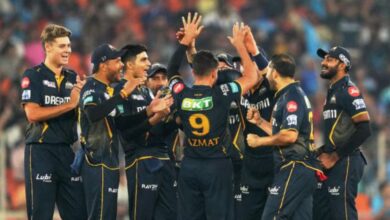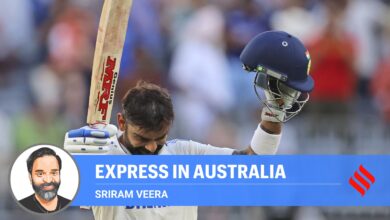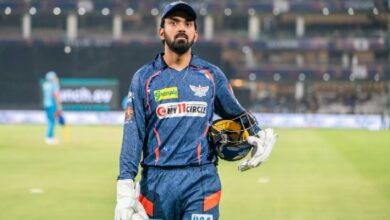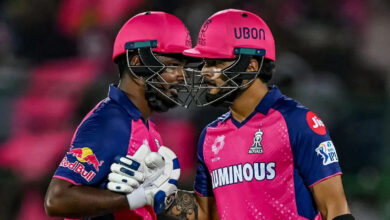Back from darkness: Olympian-coach Dipankar back on court after treatment of brain tumour

It was rapid loss of vision that alerted Olympian and now badminton coach Dipankar Bhattacharya to a brain tumour, for which he got treated back in February 2021. After recuperating, Bhattacharya has been back on the training courts for the last few months, and even travelled to the Badminton Nationals recently, to shepherd a bunch of careers he has been looking after at his Navi Mumbai academy.
“I was not able to see properly, and thought I probably needed to change my glasses. The optician said I better consult an ophthalmolog. They found an obstacle to the optic nerve which was a tumour,” he says, adding that it wasn’t malignant.
“Initially, I was shaken because we associate tumours with malignancy. I thought I had a few days to live, so I started preparing for my wife and son. I gave myself a 50 percent chance of survival,” he added.
The dent inside the skull post surgery, though, meant the cerebrospinal fluid would flow out of the nose. “It took a month to control and then I started feeling better. Slowly, I started going out to the court. Now I’m coaching like before,” Bhattacharya, 51, added.
First Olympian
Bhattacharya is a double Olympian (he went to the 1992 and 1996 Games), and recalls how injury layoffs were the only time he used to be kept away from the courts. “Ahead of the Atlanta Olympics, I injured my wr pretty badly. In those days, you needed to run from pillar to post to get therapy,” he recalls. His treatment for the tumour was facilitated his employers, who had a tie-up with a city hospital known for its special.
Back in 1995, the wr finally healed towards the end of the year. “My ranking had really dropped before I played five tournaments in Europe,” he recalls.
Decent results at the Swiss, Swedish, All England and French Open yanked his rank back to World No 48, pipping Pullela Gopichand. He would qualify for the 1996 Games but lose early to Hariyanto Arbi. The Atlanta experience wasn’t the happiest. The Games got played at University courts.
Dipankar Bhattacharya alongside Pullela Gopichand. (Special Arrangement)
“There were three courts and a much smaller arena. Athletes stayed in the Georgia Tech hostels. And there was a blast at the Olympic exhibition centre. All in all, Barcelona was much friendlier,” he adds. He would watch Mohammad Ali light the Olympic torch at Atlanta, though.
The Barcelona Games were also memorable due to the opening ceremony spectacle. “It was one of the best opening ceremonies when the archer lit the torch with an arrow. It was perhaps the greatest effort not seen before or after. We were dumbfounded wondering how they managed to keep their nerve in front of so many people.”
The 1992 Games saw badminton’s debut at the Olympics, and carried a few features of novelty. “It was like any other tournament except with more rest in between. They used to wait for the IOC top guys like Juan Antonio Samaranch to come and witness the best matches.”
He also saw a humidity measuring device being brought out the umpires for the first time, to ascertain the right flight of the shuttle.
“I remember meeting Linford Chrie and taking a photograph with him the day after his 100m race at the Games Village breakfast.” Bhattacharya would exit in the Round of 16 to Chinese Zhao Jianhua.
Adding new weapons
Throughout his career in which he won three national titles and reached the Olympic pre-quarters, Bhattacharya came to be renowned on the national circuit for his jump smashes. “My father was a keen observer of the game and did good analysis. He used to tell me that badminton is a game of the legs and not so much of the hand. So as a junior, we focused on leg strength. I used to do a lot of skipping and could also do a triple-skip which is very rare,” he recalls.
The jump smash was the logical next step. “My father also explained to me that if I could intercept the shuttle early jumping high without going to the baseline I would save time and get an advantage for the next stroke. That was how it all started and the jump smash was the next thing coming as I developed adequate leg strength. Later on as I started to travel abroad, I watched the Chinese and Indonesian players jumping and worked on perfecting the jump smash and the contact timing which made my smashes very hard and penetrative.”
It would take him two decades to put into place a full-fledged academy in 2015. “I even had a Malaysian coach, but Covid spoiled everything.”
But much before, it was his generation that took to coaching in large numbers. “When we were coming up, not many of our seniors got into coaching. Gopi took the bold step, built a good academy and produced Saina Nehwal. And then PV Sindhu. In our times, we couldn’t even dream of winning an Olympic medal. The medal increased interest in shuttle around the country,” he says. “I’d give credit to Prakash sir and Gopi for starting academies.”
The year-long stint under a Chinese coach in India, though, was an eye-opener. “He changed the entire perspective. We were more athletes than badminton players till then. He focussed on on-court training.”
Bhattacharya’s own coaching philosophy is guided an incident in his early years. “As a sub- junior, I was written off one of the coaches. He told us to stop, ‘you can’t make it.’ But my father never gave up and said if I train, I’ll make it. I left no stone unturned.”
It’s why he refuses no one who is keen to learn, and doesn’t strictly go scouting certain parameters. “I believe you can make anyone a champion with a little more effort and time and getting into the minute points,” he says.
Having gone through a serious ailment, Bhattacharya is willing to bide his time. “Badminton is very competitive and I’ll keep patience for as long as it takes. Thankfully, parents understand that. Also, you don’t always get results in age-group tournaments due to age- fudging. You have to wait until puberty hits when all come at par. It’ll take another two years for my trainees to make a mark,” he adds.







